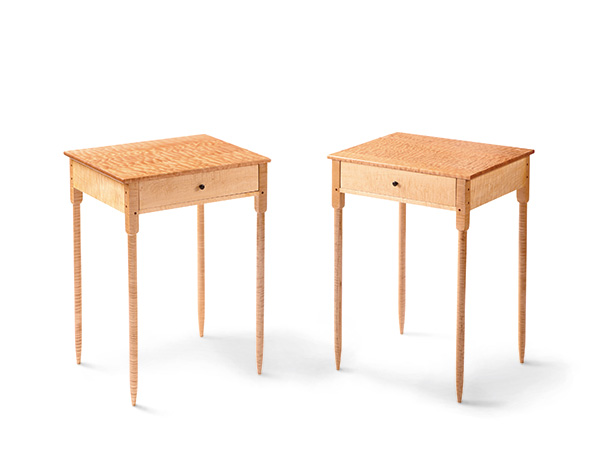
The Shakers were part of a larger 19th-century cultural cycle that became known as the Utopian Movement. By separating themselves from the world and basing their behavior on societal norms of their own determination, the Shakers and other groups attempted to create a better world — one small group at a time. Other groups, like the Millerites and the Amana Society, were similar in their separation, but the Shakers were unique in the degree to which their beliefs permeated nearly every aspect of their lives. Their spiritual beliefs affected everything from the way they preserved food to the clothing they wore, behavior regarding procreation and even the furniture they built. And that’s where this project finds its origins. The table that these replicas are based on was built in the 1850s. I found an image of the table, along with some measured drawings, in an old book.
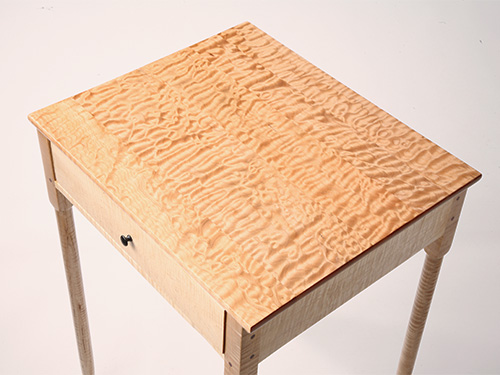
Never having attempted an historic reproduction before, I approached the project with an increased level of curiosity and a degree of caution. The Shakers designed their furniture to be ultra-functional and soundly built but with an eye to being efficient with the wood (a concept common to woodworking today). They regularly used solid material that was resawn to 1/2″ to 5/8″ thickness, rather than our default 3/4″ thickness. Simplicity was a key element of beauty in their philosophy. Although lightly built, the fact that many of their pieces remain functional over a hundred years from their construction speaks to the strength of the joinery. And all of this was intentional. Once, when I was talking to woodworker Norm Abram about finding inspiration from projects of the past, he observed how folks who build Shaker projects these days often substitute thicker stock for the original dimensions and how negatively that small change affects the look of the pieces.
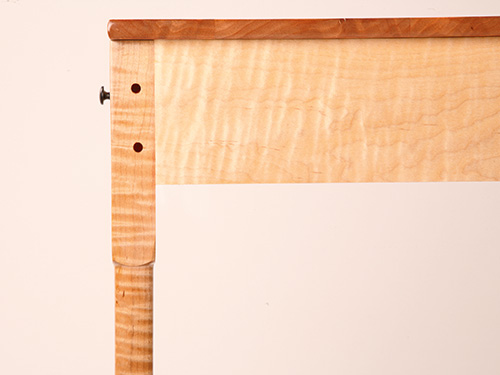
As I was getting started, I remembered that conversation and decided to be as true to the original piece as I could regarding the various component sizes. But when it came to the material I used, I decided to veer about as far from the original as I could and still remain on the planet.
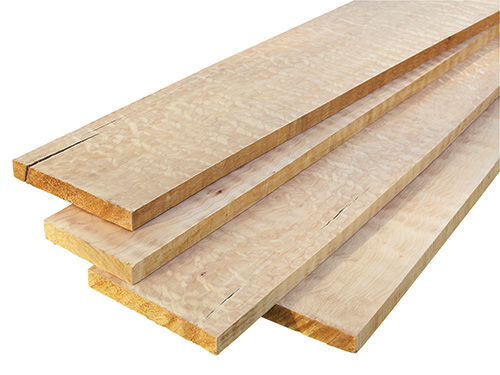
It was impossible to determine from the black and white photo what species or combination of woods the original was built from. No doubt it was locally harvested and cured (another concept that is coming back into vogue). What I could see was that it was painted, and so for that reason the type of wood was not aesthetically important. For my tables, I decided to find some exceptionally beautiful wood and incorporate it into the simple Shaker design. I used highly figured flame maple for the legs, aprons and drawer fronts and, after a good deal of calling around, found some stunning maple in a clouded (or “bubble”) pattern for the tops.
Building from the Ground Up
I began by creating a Material List from the old measured drawings. Even though these drawings were exceedingly helpful, they left a couple of details out. First, how was the top attached to the underframe, and second, how was the drawer supported and guided? These two details ended up being interconnected, but I was unaware of that until later.
As I indicated earlier, I extended a significant amount of effort locating maple with very dramatic grain patterns. I also brought the stock into my shop and let it adjust to the environment for several days. I had decided in advance that I would use the tables on either side of my bed, so I selected sufficient wood to make two of them.
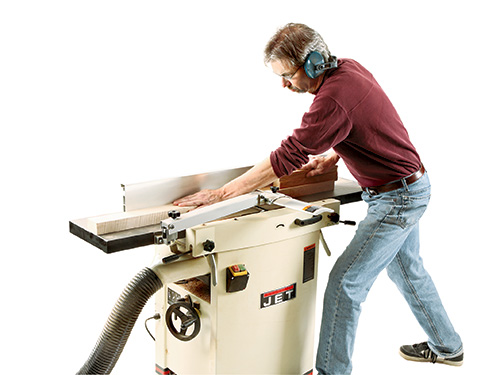
I started by making the legs (pieces 1) from flame maple stock. Although the final squared-up dimension of each leg is 1-3/16″, the heavy lumber I located was almost 1-3/4″ thick as I began. After carefully inspecting the material to get the best looking grain from the stock at hand, I rough cut pieces to about 30″ long and about 3″ wide. To create turning blanks for the legs, I started out on the jointer. I face-jointed the stock to get a perfectly flat plane on the wide face, then I jointed an adjacent edge so that it was straight and a perfect 90° to the first face. (Be sure you mark each piece so that you don’t confuse which two faces are trued up to one another.)
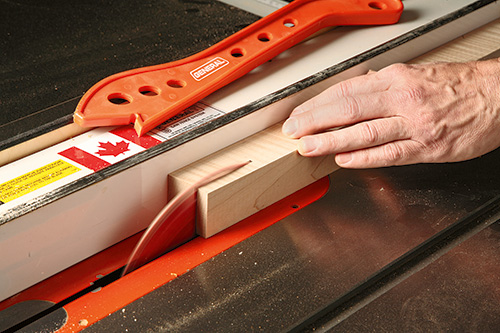
With the table saw blade set accurately to 90° to the table, I adjusted the fence to a distance of 1-3/16″ plus a bit — less than a 32nd of an inch strong — this extra dimension would be removed while I was sanding the legs later. I made the first cut on my roughed-out blank with the flat face down and the squared edge on the fence and then made the next cut in the remaining blank in the same fashion. Then I lowered the blade a bit and, with the squared faces once again on the table and against the fence, finished cutting out my leg turning blanks. While you could choose to mark out your mortises and chop them out now, I proceeded to the lathe first. My thought was if I messed something up while turning, or the leg decided it wanted to distort in some way after I removed material, I could discard it without having invested the time and effort of chopping the mortises.
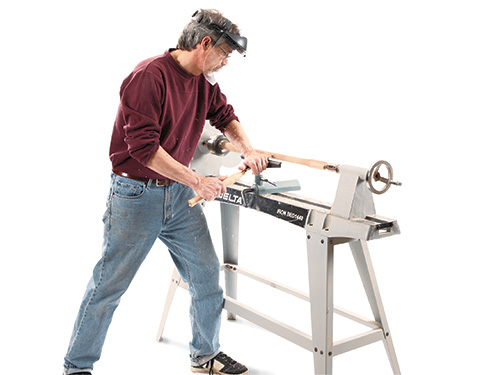
I must confess to being more of an enthusiastic turner than an expert one. And what skill I have is as a result of the bowls that I turn. So, with a bit of research and some practice, I learned a few things about spindle turning while making these tables. As you can see from the Drawings, the legs have a 6″ long rectilinear section at their top but are cylindrical for most of their length with a gentle taper that starts 4″ from the bottom. They are not at all tricky to make, but if you are not experienced in spindle turning, I recommend turning a test leg from scrap stock to get things started. As I completed each leg, I sanded the turned section right up through 400-grit sandpaper. It was my plan from the get-go to put a silky smooth finish on the table, and surface preparation is key to that aim.
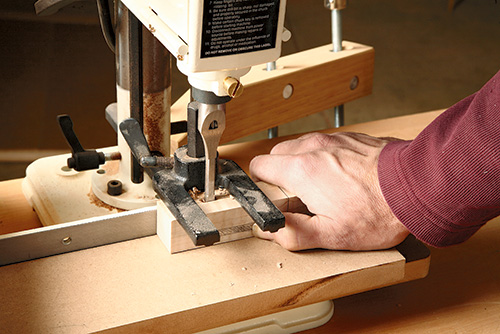
When I was done with the turned portion of the legs, I grabbed the lot of them and moved to my mortising machine. I laid out the mortise locations (you can find them on the Drawings) and set up the machine to chop out the material. The tenons will be 3/4″ long, so the mortises must be that, plus 1/16″. Don’t be surprised that the apron mortises intersect a bit on the back legs, it is just fine.
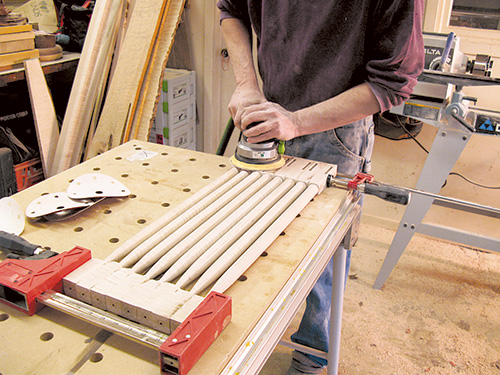
Once the mortises were done, it was time to sand the rectilinear sections of the leg up through the grits (once again I conclude with 400-grit, but I only machine sanded through 220-grit and finish sanded by hand later, after the underframe subassembly was put together). To keep the parts square while doing all the machine sanding, I clamped them together in quadruples. Once I completed the machine sanding, I cut them to length and set them aside. I was ready to move on to the aprons and stretcher.
Machining the Aprons and Stretcher
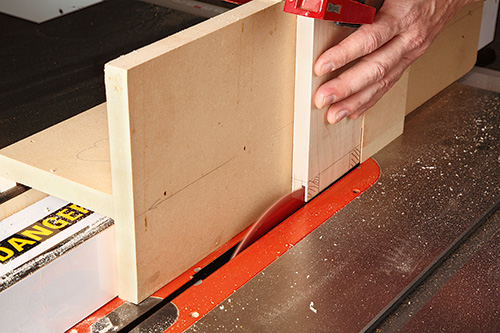
Once again, it’s important to harvest parts with grain pattern and color as the primary goal. The aprons and the stretcher (pieces 2, 3 and 4) all have tenons raised on their ends. One face of each of these pieces is flush to the outside faces of the legs. I used a shop-made tenoning jig on the table saw to form all of these tenons (although you can use the method of your choice). I took my time here, marking them out carefully, noting which face would be the “show” face. The construction details are shown in the Drawings. Note that on the tenons inserted into the back legs, the ends are mitered (because of those intersecting mortises).
A Mid-course Correction
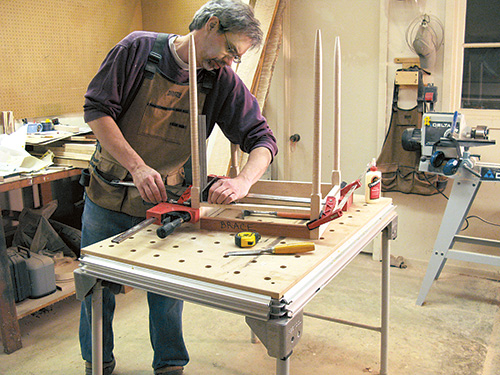
Once the tenons were formed, it was time to dry-assemble the underframes. There was a bit of adjustment to be made and, when I looked at the clamped-up units, I knew that I needed to add drawer supports (pieces 5) for the drawers to rest on as they slide. I made the supports and glued them in place, aligned with the stretcher. I also made the decision to attach the tops to the underframe with metal tabletop fasteners. This turned out to be a big mistake: unfortunately, when I looked closely at the dry-fit subassembly, I could see that the fasteners would be in the way of the drawers. The solution? Tabletop cleats (pieces 6) that run the length of each side apron. I drilled elongated holes in the cleats (see the Drawings) and glued them 1/16″ below the top edge of the aprons. They also had the added benefit of guiding the drawers accurately within the drawer cavity. I wish I could say that I had reasoned this out from the beginning, but that is not the case. Although I can’t be certain, the simplicity and elegance of these solutions cause me to think that they were likely a part of the original table’s construction.
With the dry-fitting and additional details completed, it was time to glue up the underframe. I used a brace in the drawer opening to help keep the parts square and true during this process. Once they were in clamps, I set them aside and moved onto the tabletops (piece 7).
The remarkable figure in the lumber was both beautiful and challenging to work with. I would need to laminate the tops using butt joints, so selecting and arranging the various pieces to look their best was fairly involved. The tops have a finished thickness of 1/2″, but my material was 3/4″ thick. I had intended to resaw the pieces to save some thin slices of the wood, but after face-jointing them, I felt there was simply not enough material remaining — so I ended up just planing them to thickness. It was frustrating to turn such lovely wood into chips!
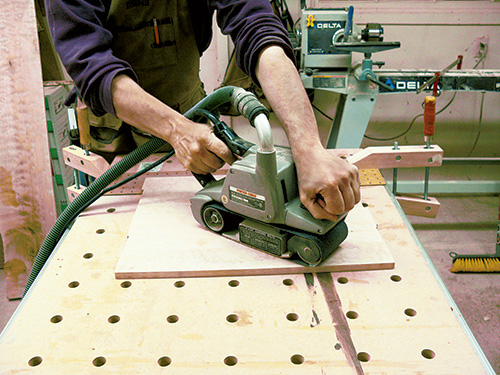
After I glued up each top (slightly oversized in length and width), I used my old 4 x 24 belt sander to flatten each piece by sanding on diagonals until all of the glue joints were level with the face of the top. At that point, I cut the tops down to their exact size and then routed the soft bullnose on their edges. Because the grain was so wild, I shaped the end grain first, using a climb cut to avoid tearout. After routing, I hand-sanded the edges from 80-grit all the way through to 400-grit. Then I resumed sanding the tops up through 400-grit paper. When they were done, I took the underframes out of their clamps and, after taking a few minutes to lay out, drill and insert the tenon pins (pieces 8), I got busy sanding on the aprons. Just as an aside, the sanding effort on these tables, to get the results I was after, was measured in hours, not minutes.
Dovetailed Drawers and the Finish
The drawers, in true Shaker fashion, are both simple and sophisticated, with half-lap dovetails at the front and through dovetails at the back. There is nothing out of the ordinary about these drawers other than, once again, I used some really lovely wood for the fronts. I chose to make the dovetails by hand, but jig-cut dovetails would look just fine. After I had cut out and machined the drawer parts (pieces 9 through 13), I dry-fit them and then moved on to assembly. Once the glue cured, the drawers needed little fitting and, with the exception of the tabletop hardware false start, everything went really well. (Oh … did I mention that I sanded the dickens out of them?)
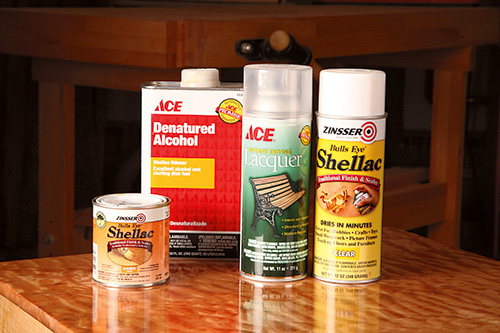
As indicated earlier, I had the finish well conceived before I started the project. But a challenge arose when it became clear that, even though all the various parts of the table were made from soft maple, there were distinct color differences in the legs, aprons and the tops. By putting a finish on scrap wood pieces from the various parts, I found that the tops, with a clear finish applied, presented a rich honey color. The legs, on the other hand, had a slight grey cast to them. The aprons, drawer fronts and stretchers had a pure, paper-white hue. It is my personal preference in most cases to simply let the natural colors of the wood come through, and if there is a range of colors, so be it. But in this case, I found the difference to be too extreme, so I worked to at least reduce the range of variation. I tried an oil stain alone on the underframe stock, but the result looked blotchy. I tried it again with a wash coat of shellac thinned 50 percent … better, but I was still unhappy with the results. In the end, I applied a coat of Natural Watco® Oil to the underframe and allowed it to cure. Then I applied a coat of amber shellac, thinned 25 percent with denatured alcohol. I followed with three spray coats of lacquer, de-nibbing with 0000 steel wool between coats. On the tops, I applied three coats of sprayed-on shellac (again de-nibbing between coats) and then a final coal of lacquer. These tables were small enough that I had no problem achieving really good results using areosol spray cans to apply the finish. And, while there is still a visible difference in the color of the various parts, I think they look fine together. After allowing two weeks for the finish to fully cure, I rubbed it out with paste wax, and the job was completed.
These tables were my first effort at historic reproductions and I have to say that I truly enjoyed the experience. And, while the tables may not be 100 percent as the Shakers would have built them, I think they evoke their spirit very well indeed.





